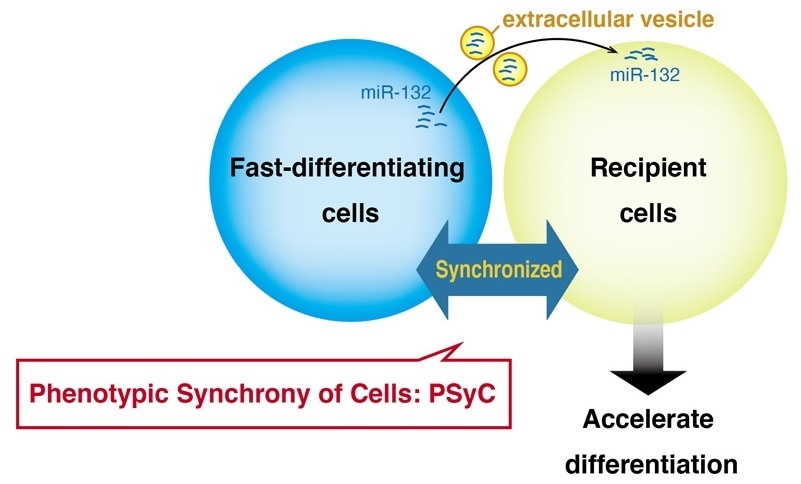Cells in the body work together, similar to an ant colony or even people in an office achieve the tasks. And in all cases, this cooperation relies on communication. Ants achieve communication through smell and people with the help of sound.

The Jun Yamashita laboratory describes PSyC, a new method by which cells exchange vesicles to synchronize their activities. Image Credit: Kyoto University.
Cells also communicate by passing vesicles through a system named phenotypic synchrony of cells, or PSyC, as demonstrated in the recent research by CiRA scientists.
The human body starts as a single cell, the embryo. The single-cell divides and later various subsets of cells start to form different tissues and organs. To achieve this, the cells, particularly the ones near one another, must constantly communicate to coordinate their activity.
Cells must differentiate together to form normal tissues and organs. We know the signaling pathways and gene networks for individual cells, but we don't know much about how the cells synchronize.”
Jun Yamashita, Professor, Center for iPS Cell Research and Application, Kyoto University
Professor Yamashita headed the research.
The embryonic stem cell epitomizes one of the first cell types at the time of embryo growth and hence is mostly employed to analyze the very first steps for the advancement of any part of the body. To find out PSyC, the scientists employed a special type of embryonic stem cell designed by them.
We made embryonic stem cells that have protein kinase A constitutively active. This accelerates the differentiation of the cells.”
Tomohiro Minakawa, Center for iPS Cell Research and Application, Kyoto University
Tomohiro Minakawa put forth the project and carried out most of the experiments.
A group of embryonic stem cells mostly will exhibit synchronized developmental patterns. But as protein kinase A embryonic stem cells displayed rapid differentiation, Minakawa and his co-workers anticipated that combining the embryonic stem cells with regular embryonic stem cells will interrupt this synchronicity and lead to two groups with various differentiation rates.
But the researchers did not observe what they expected. Even though there was a change in the differentiation rate of the two kinds of cells initially, the normal embryonic stem cells ultimately caught up to their protein kinase A counterparts. The research names this catching up as PSyC.
PSyC was only seen if the cells were in close proximity. But if we put some distance between them, the effect was lost. This suggested the cells in close proximity were communicating by passing vesicles between each other to perform PSyC.”
Tomohiro Minakawa, Center for iPS Cell Research and Application, Kyoto University
Cells exchange chemicals and molecules between one another by enclosing the content inside an extracellular vesicle, similar to putting a letter into an envelope. The extracellular vesicle is later discharged from the cell and attaches to or is absorbed by another cell. The extracellular vesicle then opens to discharge its package inside the second cell.
Subsequent investigation showed that amidst the different kinds of biomolecules passed by extracellular vesicles was microRNA-132. This exchange triggered the embryonic stem cells to mesoderm cells by PSyC. To substantiate this point, the scientists delivered microRNA-132 inside nanoparticles to the cells and observed a similar effect.
Yamashita remarked that the function of extracellular vesicles in cell communication was not new but the revelation that the vesicles synchronize cell activity was new.
Yamashita remarks, “We already knew that extracellular vesicles are used for cell-to-cell communications. But PSyC shows that they can be used to synchronize cells for cell fate and differentiation.”
Source:
Journal reference:
Minakawa, T., et al. (2021) Extracellular vesicles synchronize cellular phenotypes of differentiating cells. Journal of Extracellular Vesicles. doi.org/10.1002/jev2.12147.